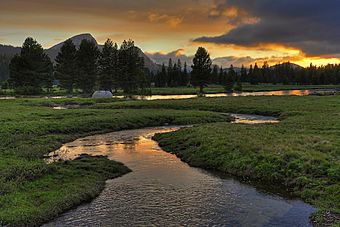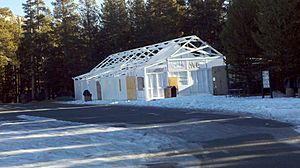Tuolumne Meadows facts for kids
Quick facts for kids |
|
|
Tuolumne Meadows
|
|

Sunset over Tuolumne River by Tuolumne Meadows
|
|
| Lua error in Module:Location_map at line 420: attempt to index field 'wikibase' (a nil value). | |
| Nearest city | Lee Vining, California |
|---|---|
| Area | 0.4 acres (0.16 ha) |
| Built | 1934 |
| Built by | Civilian Conservation Corps |
| Architect | Wosky, John |
| Architectural style | National Park Service rustic |
| NRHP reference No. | 78000371 |
| Added to NRHP | November 30, 1978 |
Tuolumne Meadows is a beautiful, open area found in the eastern part of Yosemite National Park in the United States. It's a wide, flat space along the Tuolumne River, surrounded by cool, rounded granite hills called "domes."
This special area is about 8,619 feet (2,627 m) high. People often use the name "Tuolumne Meadows" to talk about a much bigger part of Yosemite's high country, especially when they are discussing rock climbing adventures.
Contents
Nature's Wonders in Tuolumne Meadows
The plants and flowers in Tuolumne Meadows get their water from underground. Most of this water comes from about 1,000 mm (39 inches) of snow that falls each year. When the snow melts, water flows into the Tuolumne River and other smaller streams like Budd Creek.
In spring, right after the snow melts, you might see large parts of the meadows covered in water, almost like small lakes! Even though the mountains nearby have some snow all year, most of it melts in summer.
Plants and Wildflowers
Tuolumne Meadows is home to many different kinds of plants and wildflowers. The types of plants you see change depending on how much water is in the soil.
- Areas with lots of water have plants like the inflated sedge and Sierra willow.
- Other wet areas have beautiful flowers like the alpine aster and western bistort.
- In drier spots, you'll find thread-leaved sedge and Sierra lodgepole pine trees.
Keep an eye out for the Purple Webber, a somewhat rare type of lupin flower, which blooms in late spring and summer.
Fun Things to Do in Tuolumne Meadows
Tuolumne Meadows offers amazing views of the Cathedral Range and Unicorn Peak. You can also see Lembert Dome and Mount Dana from here. It's a great place for outdoor activities!
You can go camping at the Tuolumne Meadows campground, but it's a good idea to book your spot ahead of time. This area is usually less crowded than Yosemite Valley, making it a peaceful spot for hiking and rock climbing.
The main road to the meadows, Highway 120, is usually clear of snow from June through October. Because the area is so high up, the road closes during the winter.
Hiking Adventures
Many exciting hiking trails start in Tuolumne Meadows. You can even begin the main path to climb Mount Lyell, which is the highest peak in Yosemite National Park.
Two very long hiking trails, the John Muir Trail and the Pacific Crest Trail, pass through Tuolumne Meadows. Many backpackers hike these trails every year.
There are also many shorter day hikes you can take, like to Gaylor Lakes, Cathedral Lakes, and Lembert Dome. These trails are popular in the summer. A shuttle bus helps hikers get to and from these trails, usually from June to September, but this can change based on the weather.
Rock Climbing Challenges
Unlike the huge rock faces in Yosemite Valley, climbing in Tuolumne Meadows is usually on shorter routes. These climbs are found on about eleven main "domes" and some smaller ones. These domes stretch from the Stately Pleasure Dome near Tenaya Lake to Lembert Dome.
Since the area is at a high elevation, the best time for climbing is from June through September.
The rocks here are made of a very strong type of granite. This granite tends to peel off in layers, which helps create and keep the unique dome shapes. Climbers can find both face climbs (where you climb on the flat surface) and crack climbs (where you climb in cracks in the rock).
Some of the major domes for climbing include:
The peaks of the nearby Cathedral Range, like Cathedral Peak, are also popular climbing spots.
How Tuolumne Meadows Was Developed
The Tioga Pass Road (California SR 120) helps people get to Tuolumne Meadows. This road was paved by the 1920s. Its current path through the meadows was designed in the 1930s by the Civilian Conservation Corps (CCC).
The CCC was a group that helped build many things in national parks. They built some great structures in Tuolumne Meadows, which are now listed on the National Register of Historic Places.




